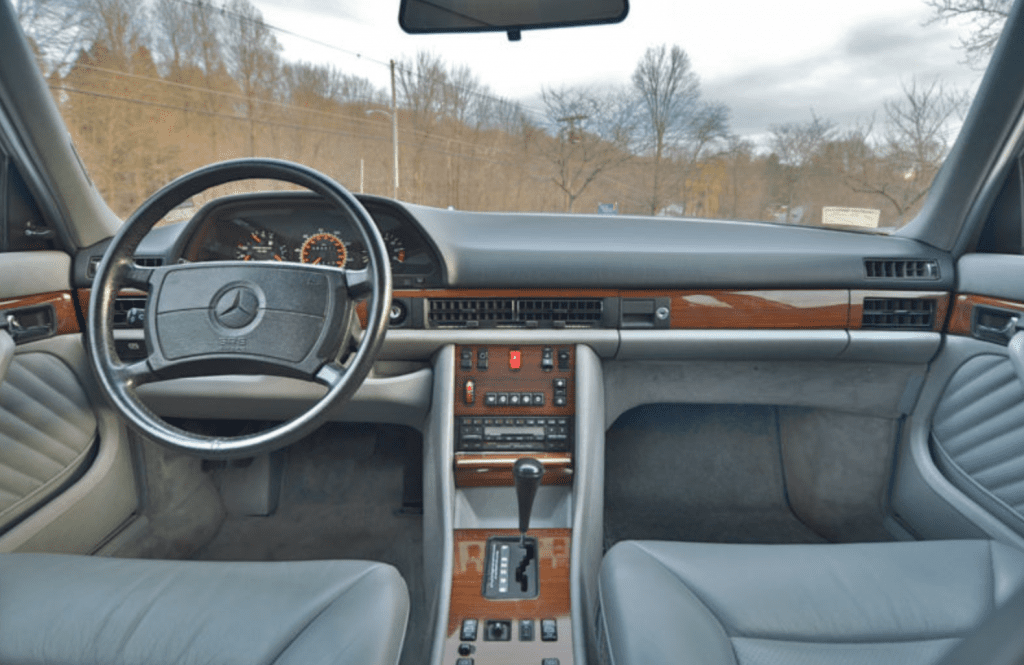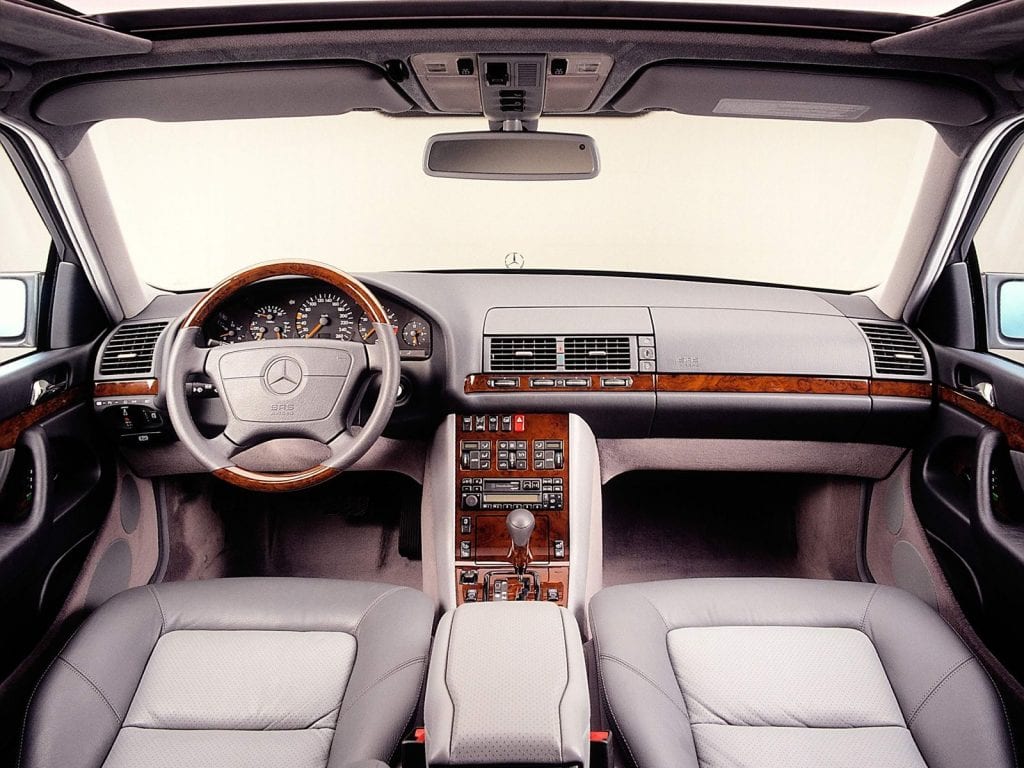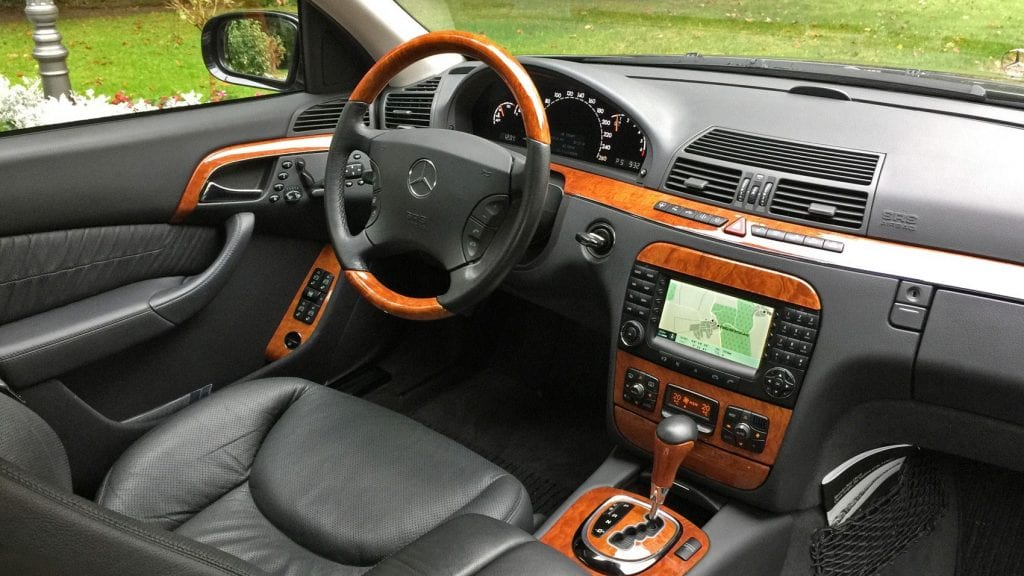Which Used S-Class Should You Buy? W126 vs. W140 vs. W220

Introduction
They say there’s nothing more expensive than a cheap Mercedes. And if by “cheap” they mean run down, neglected, and worn out, they’re absolutely right. But the truth is, even though a Mercedes S-Class represents the very best in German engineering and can sell for well over $100,000 when new, you can find outstanding used examples for as little as $10,000. You just have to know how to look.
That’s why we’ve put together this guide to the most affordable S-Class generations from the last 40 years. Check it out to learn which one is right for you.
W126 Buying Tips
The Mercedes S-Class officially debuted with the W116 chassis in 1972. However, our first picks come from the second generation, known internally at the manufacturer as the W126. That’s no slight to the original, which was a revolutionary car in many ways. But with most remaining W116 specimens now pushing 50 years old, they’re best left to the collector and restorer crowd.
On the other hand, it’s still possible to find a used W126 S-Class in good, original condition, and the newest ones are “only” 30 years old. We recommend targeting your search to the very newest W126 you can find — specifically, from the 1986 or later model years. That’s because Mercedes made significant changes to the car starting then, improving not only performance but also looks and reliability.
While the original version of the W126 was handsome enough, the car really came into its own with the 1986 model refresh, which streamlined Bruno Sacco’s iconic design with flush headlights and smooth lower-body cladding. Bigger 15 inch “Gullideckel” wheels further improved the looks as well as road feel, while an updated interior offered more luxurious appointments. Safety improved, too, with both ABS brakes and a driver’s air bag included on all versions.
The 1986 refresh brought a suite of new engine choices, too. Brand new to the S-Class was a 3.0 liter inline six (codename M103) producing 177 hp, which was offered in the 300SE/SEL, as well as a turbodiesel 3.0 inline six (OM603) making 148 hp, available for 1986-87 only in the 300SDL. The diesel option may sound slightly anemic, but the torquey oil burner provides ample shove while still delivering surprisingly good fuel economy for a large car (over 20 mpg on the highway). Two V8s carried over from earlier years, but with additional displacement and power: the 201 hp 4.2 liter M116 in the 420SEL, and in the top-of-the-line 560SEL the 5.6 liter M117, producing 238 hp. All were paired with Benz’s only available transmission option (in the U.S.), a traditional 4-speed automatic.

Mercedes offered the W126 in standard- and long-wheelbase versions (designated by an “L” added to the badge, e.g. “300SEL”). The latter adds almost 6 inches to its length, which increases rear seat room considerably. That said, we tend to prefer the overall proportions and driving dynamics of the standard-length cars, which were limited in the U.S. to just two offerings: the M103-equipped 1986-91 300SE and the diesel-powered 350SD, which was available for 1990-91 only.
If you’re looking for the most bang-for-your-buck in a W126, we recommend targeting either the six cylinder 1986-91 300SE/SEL, or if you want a little more oomph, the V8-equipped 1986-91 420SEL. These sold in the greatest numbers in the U.S, so they’re now the most widely available models. That means you can be extra choosy when you’re looking (very important) — and also that their prices haven’t been driven up by a limited supply. These models also lack some of the features included on the flagship 560SEL model, such the hydro-pneumatic rear suspension, which can add complexity and cost to your ownership experience.
The diesel-powered versions are terrific, too, particularly the 1986-87 300SDL. However, because they are such great long-haul cruisers, they’re difficult to find without mega miles. And if you do find a cherry example, it tends to command a premium price. We’re less enthusiastic about the later diesel variant, the 1990-91 350SD/SDL, because its 3.5 liter OM603 engine can suffer from a head gasket issue that allows oil into the #1 combustion chamber, leading to bent connecting rods.

W140 Buying Tips
The engineers in Stuttgart began working on a successor to the second generation Mercedes S-Class almost as soon as the W126 was launched. Dubbed internally as the W140 (and nicknamed by some as the “Big Body” Benz), the third gen S-Class debuted for the 1992 model year (in the U.S.) after nearly a decade of development, at a reported cost of over $1 billion. The result was the biggest, most powerful, and most imposing Mercedes flagship since the 600 Grosser.
As with the W126, cars from the initial years of the W140 generation have proved to be somewhat problematic to own. Gasoline-powered models from 1993-95 suffer from biodegradable wiring harnesses, which are fixable but afterwards can have lingering side effects. And the diesel-powered versions have the same troublesome engine from the 1990-91 350SD/SDL. The W140 also introduced a host of new electronics, and without the more sophisticated OBD-II on-board diagnostics, which became standard in 1996, it can be difficult to track down issues with the dozens of sensors and relays running throughout the car.
For those reasons, we recommend seeking out W140 examples from the latest years of production, specifically 1996-98. Cars from these years also benefit from a major model refresh, which modernized the appearance inside and out, eliminating the earlier cars’ two-tone paint scheme and adding Xenon headlamps, rain-sensing windshield wipers, and front door-mounted side-impact air bags, among other desirable features. They also have a new electronically-controlled 5-speed automatic gearbox (722.6), which is far more responsive than the prior 4-speed unit.
Starting in 1994, Mercedes revised the S-Class nomenclature, so what was the “500SEL” became simply the “S500.” The numerical part of the name still reflected the engine size, with the S320 featuring a 3.2 liter 228 hp inline six (codename M104) and the S420 a 4.2 liter 275 hp V8 (M119). The S500 offered a 5.0 liter version of the M119 V8, making 315 hp, while the top-of-the-line S600 featured a 6.0 liter V12 mill (M120) producing 389 hp.
If your aim is to keep your W140 acquisition and running costs to a minimum, we’d steer you away from the V12 model. The M120 is a spectacular engine with a reputation not only for near-silent and EV-quick acceleration but also surprisingly good reliability and durability. The downside with the S600 is that as the W140 flagship it’s so packed with other features, like a hydro-pneumatic suspension, that maintenance and upkeep can be more challenging than with the lesser versions. S600s are also far rarer, which means that nice ones are both harder to find and more expensive.

On the other hand, well-kept examples of the S320, S420, and S500 from 1996-98 aren’t uncommon and can be found for as little as $7500. As noted before, the W140 is far more complex than the W126, so it’s absolutely critical to find one that has been properly looked after, with the service records to prove it. Since condition is the most important factor here, we’d suggest focusing more on that in your search than narrowing it to one specific trim.
That said, if you find a great 1996-98 S500, snap it up. The combination of the 5.0 liter M119 V8’s torque (420 lb-ft) and the responsive 722.6 5-speed automatic is a great match for the large W140 chassis, which clocks in at a hefty 4700 lbs. After driving an S500, you may find the lesser motors somewhat lacking.
Also worth noting is that all 1996-98 W140s came to the U.S. in long-wheelbase spec, with the exception of the S320, which was available in both standard (SWB) and long (LWB) versions. So if you happen to prefer a shorter W140, the S320 is your best choice.

W220 Buying Tips
In response to feedback that the W140 was too extravagant — not to mention its exorbitant development costs, which nearly bankrupted the company — Stuttgart decided to dial back its next Mercedes S-Class considerably. The result, known as the W220 generation, is a smaller and more generic-looking car, which has become perhaps the least-loved of any “Sonderklasse” in history. In fact, YouTuber Doug DeMuro somewhat jokingly placed it 999th in his ranked list of all S-Classes.
But we think that’s all the more reason to consider one. When the conventional wisdom turns against a particular model, its values plummet, and suddenly it becomes possible to find real gems sparkling through what others see as a worthless pile of rocks.
The W220 actually garnered substantial praise when it debuted. In its May 1999 issue, Car and Driver sampled an S500 from the new generation and came away calling it “possibly the finest automobile built.” Its sleek shape offered the lowest coefficient of drag (0.27) of any production car at the time, and Benz’s pioneering use of lightweight materials like aluminum and magnesium throughout the body led to a 500 lb weight drop from the outgoing model. Meanwhile, inside, the W220 offered a wonderland of tech and safety equipment the likes of which had never been seen, including ventilated seats, a voice-activated telephone, emergency brake assist, and radar-assisted adaptive cruise control (aka Distronic).
Ironically, it was this very leap in advanced features that led to the W220’s poor reputation. Early teething issues with the tech led to nightmarish ownership stories, and as the cars have aged, their complex systems, such as the available Airmatic air suspension, have proved costly and challenging to maintain. With their drop in both value and reputation, many W220 examples have suffered from neglect. It’s more common now to see them being towed on flatbeds or looking sad with sagging suspensions than showing pride of ownership.
Still, good examples can be found, and if you tread carefully you can find excellent cars with plenty of life and enjoyment left in them. In particular, we recommend seeking out the one-year-only S350 version, which Mercedes offered in the U.S. for the W220’s final model year (2006). It’s a rare standard-wheelbase version that features one of Benz’s most reliable powertrains: the 3.7 liter M112 V6, making 241 hp, backed by the robust 722.6 5-speed automatic gearbox. It’s no powerhouse but rather a relaxed cruiser that gobbles up highway miles and is also relatively nimble in town. And unless highly optioned, S350s also lack most of the troublesome gewgaws that can plague other W220s.

If you can’t find a nice S350, our advice for keeping your W220 expenses to a minimum is to look for the newest and least-optioned example you can find. Specifically, we recommend sticking with cars from the 2003-06 model years, which were vastly improved after a mid-cycle refresh. We also suggest steering clear of the powerful AMG-tuned variants, the S55 and S65. While certainly appealing to look at and drive, their bespoke parts and added features (like Active Body Control) add substantially to the cars’ complexity and running costs.
The W220 was the first S-Class to offer all-wheel drive, or 4matic in Mercedes speak. An added benefit of 4matic-equipped W220s is that they come with the more reliable 722.6 5-speed automatic. (A newer but less robust 7-speed ‘box was fitted to most rear-drive versions starting in 2005 and is worth avoiding.) So unlike many of the W220’s other bells and whistles, 4matic is actually a plus.
The Bottom Line
As long as you stick to our recommended models and years, you should be able to find outstanding examples of the W126, W140, or W220 generation S-Class for around $10,000, perhaps even a bit less. Which one is right for you comes down to a matter of taste.
The W126 offers tons of old school Mercedes style and charm, with an old school driving feel to match. These are relatively simple cars, especially in comparison to the newer S-Class generations, and consequently they’re a bit easier for an amateur mechanic to wrench on. They’re also old enough now that great examples can be pretty tough to find. But if you’re willing to put in the time, you’ll find one eventually. Another advantage is that the W126 is now widely considered a classic car, and good examples should hold if not increase their value over time.
The W140 provides a lovely blend of classic styling and modern driving dynamics — especially those from the later years of production. Though they’re all at least two decades old, well-sorted W140s put most modern luxury cars to shame by comparison. They’re quiet and powerful, and they excel at long distance cruising. Hardly anything, short of a Rolls or a Bentley, offers as much presence on the road. They’re also far more complex than the W126, and when they break they can sometimes require spendy fixes. If you’re not a knowledge Benz mechanic yourself, as a W140 owner you’ll definitely want to have one available to you in your area.
Despite being over 15 years old, the W220 is a thoroughly modern car, with the looks and features to match. It may not have the classic styling of its predecessors, but inside and out a well-kept W220 still looks sharp, and we wouldn’t hesitate to put one into daily driver duty. Plus, its lighter weight and smaller dimensions make it the most nimble S-Class on our list. But don’t let that fool you — the W220 actually offers more room inside than the larger W140. Its design is a terrific sleight of hand. The drawback to W220 ownership is keeping all of the fancy tech in good working order, so do yourself a favor and seek out examples with the fewest options.
Whichever used Mercedes S-Class you choose, buy the very best example you can find within your budget, and be sure to take it to a trusted specialist for a pre-purchase inspection (PPI) before you fork over any cash. Lest you find yourself among the ranks of those who say, “There’s nothing more expensive than a cheap Mercedes.”
Photos courtesy of Mercedes-Benz, Mecum, and Wikimedia Commons
